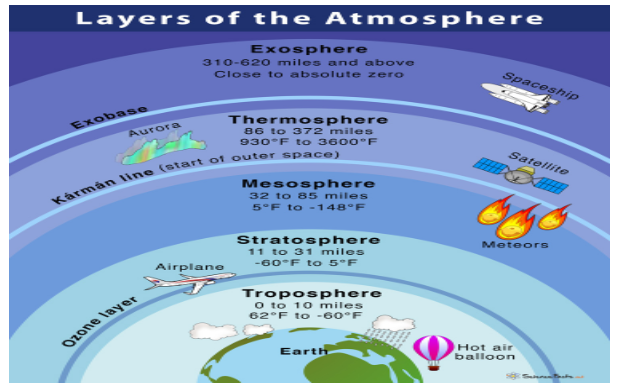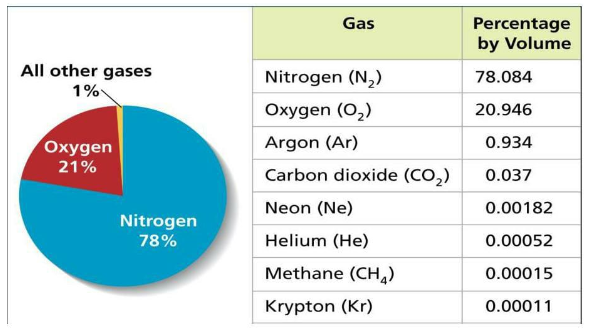Structure, Composition Of Atmosphere
ATMOSPHERE
The Earth is surrounded by an extensive layer of gases that extends thousands of kilometres above its surface. This gaseous layer is known as the atmosphere and is as important to the Earth as its land (lithosphere) and water (hydrosphere). Although the atmosphere appears relatively thin compared to the Earth's radius, it remains inseparable from our planet due to the force of gravity.
Atmospheric pressure, a key element of climate, is the force exerted by the air on the Earth's surface due to its weight. At sea level, the standard atmospheric pressure measures 1034 grams per square centimetre.
STRUCTURE OF ATMOSPHERE
The Earth's atmosphere is a blend of gases encompassing the planet, formed primarily through the degassing of the Earth's surface. It consists of five distinct layers classified based on temperature. Its vertical extent ranges between 16 to 29 thousand kilometres above sea level, with the first 800 kilometres being particularly significant.

TROPOSPHERE
- The first layer, closest to the Earth's surface, is the troposphere, extending about 8-16 kilometres above the Earth.
- This layer hosts the majority of weather events, such as cloud formation, rain, and snow.
- As altitude increases, the temperature in this atmospheric layer typically decreases by approximately 6.5 degrees Celsius per kilometre.
- Nearly all the air and water vapour, essential for cloud and rain formation, are concentrated in the troposphere.
- Its thickness varies seasonally, being least at the poles and greatest at the equator. Water vapour and particles are primarily confined to this layer and are rarely found above it. Additionally, the temperature usually decreases with altitude, and the standard decrease in temperature concerning altitude is referred to as the normal lapse rate or environmental lapse rate.
TROPOPAUSE
- The boundary that marks the separation between the troposphere and the stratosphere is known as the tropopause.
- This is the point at which the temperature ceases to decrease with further increases in altitude.
STRATOSPHERE
- The stratosphere is the second layer of the Earth's atmosphere.
- This region houses the ozone layer, a critical element protecting life on Earth from the Sun’s harmful ultraviolet radiation.
- Extending from the tropopause to a height of roughly 50 kilometres, the stratosphere contains a substantial concentration of ozone.
- This layer experiences a temperature increase with altitude due to the absorption of ultraviolet energy from the sun by the ozone.
- During summer, the poles exhibit higher temperatures, while in winter, the temperatures drop.
- Ozone in the stratosphere plays a crucial role in shielding humans from health issues caused by harmful UV rays. However, the presence of certain chemicals, like CFCs, freons, and halons, previously used in refrigerators, spray cans, and fire extinguishers, has led to a decrease in ozone levels, resulting in phenomena like the "Antarctic ozone hole."
The stratopause, marking the boundary between the troposphere and stratosphere, exists at an altitude of about 50 km above the Earth. Despite being at a similar temperature as the Earth's surface, the thinness of the air restricts significant heat transfer.
MESOSPHERE
- Beyond the stratopause lies the mesosphere where temperatures generally decrease with height.
- The mesopause marks the boundary between the mesosphere and the thermosphere, where temperatures rise significantly to almost 1700 degrees Celsius.
- The mesopause, situated at the upper end of this layer, harbors some of the coldest temperatures in the Earth's atmosphere, especially in summer near the poles.
- The mesosphere, often referred to as the "ignorosphere," has been less explored compared to other atmospheric layers.
- The stratosphere and mesosphere are collectively referred to as the middle atmosphere.
THERMOSPHERE
- The thermosphere is the atmospheric region above the mesopause where temperatures start to climb with increasing altitude.
- This layer spans from 80 to 400 kilometres beyond the mesopause.
- It's known for its ability to reflect radio waves sent from the Earth. As altitude increases within this layer, temperatures begin to rise.
- The thermosphere is where phenomena like the aurora and satellites are observed.
- The increase in temperature here is due to the absorption of energetic UV and X-ray energy from the sun. The exosphere and ionosphere are components of the thermosphere.
EXOSPHERE
- The exosphere is situated above 500 kilometres and is highly rarefied, extending into space.
- Composed mostly of oxygen and hydrogen atoms, their scarcity leads to infrequent collisions.
- Instead, they follow "ballistic" trajectories under the influence of gravity, and a few even escape into space.
- The atmosphere is divided into two distinct layers based on the protective functions they offer, with the lowest being the ozonosphere.
IONOSPHERE
- The ionosphere is a dynamic part of the atmosphere that fluctuates in response to solar energy.
- It earns its name from the ionisation of gases due to solar radiation, leading to the creation of charged ions.
- Encompassing the mesosphere, thermosphere, and exosphere, it's involved in the ionisation process, where atoms gain or lose electrons, obtaining an electrical charge.
- This layer interacts with Earth's magnetosphere, influenced by both the Earth's and the sun's magnetic fields, leading to phenomena like the auroras—striking bands of light seen near the planet's poles.
- High-energy solar particles interact with atoms in this layer, causing these spectacular displays. Importantly, the ionosphere acts as a shield against harmful shortwave radiation and facilitates long-distance communication through signal transmission.
- Gradually thinning into interplanetary space, the ionosphere serves as a vital layer within Earth's atmosphere, balancing both protection and communication.
COMPOSITION OF ATMOSPHERE

- The atmosphere is an amalgamation of various gases, along with solid and liquid particles known as 'aerosols'.
- Certain gases are constant components in fixed proportions to the total gas volume, while others fluctuate in different amounts and at different times.
- The dry air, excluding suspended particles, water vapour, and other variable gases, is relatively stable globally up to an altitude of roughly 80 kilometres.
- Higher atmospheric layers exhibit changing gas proportions, with oxygen nearly absent at about 120 kilometres and carbon dioxide and water vapour found only up to 90 kilometres from the Earth's surface.
- Nitrogen and oxygen constitute almost 99% of the clean, dry air, while the remaining gases, mostly inert, make up roughly 1% of the atmosphere.
- Additionally, the atmosphere contains significant amounts of water vapour and dust particles, both of which play pivotal roles in shaping the climate.
FAQs related to the structure and composition of the Earth's atmosphere:
1. What is the Earth's atmosphere composed of?
Ans. The Earth's atmosphere is mainly composed of nitrogen (about 78%) and oxygen (about 21%). Other gases, such as carbon dioxide, argon, and trace gases, make up the remaining 1%.
2. How is the atmosphere structured?
Ans. The atmosphere is structured into different layers: troposphere, stratosphere, mesosphere, thermosphere, and exosphere. Each layer has distinct characteristics based on temperature and composition.
3. What is the ozone layer and where is it located?
Ans. The ozone layer is within the stratosphere. It contains a higher concentration of ozone molecules and plays a crucial role in absorbing and filtering out harmful ultraviolet radiation from the sun.
4. How does the atmosphere protect the Earth?
Ans. The atmosphere acts as a shield by absorbing harmful solar radiation and preventing it from reaching the Earth's surface. It regulates temperature and maintains the conditions necessary to support life.
5. Why is the composition of the atmosphere significant?
Ans. The composition of the atmosphere affects climate, weather patterns, and the health of ecosystems. Changes in the levels of gases, particularly greenhouse gases, can significantly impact global temperatures and weather conditions.
6. What is the role of the ionosphere in the atmosphere?
Ans. The ionosphere is an electrically charged layer that interacts with solar and cosmic radiation. It's crucial for long-distance communication as it reflects radio waves and aids in the propagation of radio signals.
7. How does altitude affect the atmosphere's composition?
Ans. The composition of the atmosphere changes with altitude. For example, certain gases like oxygen and carbon dioxide diminish as altitude increases, and temperatures vary across the layers.
8. How do human activities impact the atmosphere's composition?
Ans. Human activities, such as industrialization and deforestation, release greenhouse gases and pollutants into the atmosphere, contributing to global warming and air quality issues.
9. What are aerosols, and how do they influence the atmosphere?
Ans. Aerosols are tiny solid or liquid particles suspended in the atmosphere. They impact climate by affecting cloud formation, precipitation, and the reflection of sunlight.
10. How does the atmosphere differ on other planets or celestial bodies?
Ans. The composition and structure of the atmosphere vary widely on other planets. For instance, Mars has a thin atmosphere mostly consisting of carbon dioxide, while Venus's atmosphere is mainly composed of carbon dioxide and sulfuric acid clouds.

